On This Page:
Dairy Farm Overview
Unlike beef cattle, who are bred during short time intervals so that all calves are born in early spring, dairy cattle give birth to calves throughout the year. A cow won’t start producing milk until she has had a calf, and milk products are in constant demand year round.
Dairy bulls are notoriously large and aggressive compared to beef bulls. For the safety of the farmers and the cows, artificial insemination is a common method of impregnating dairy cows. This also allows the farmer to select the most appropriate semen to impregnate a cow, and allows for technologies like genotyping and sexed semen to be used.
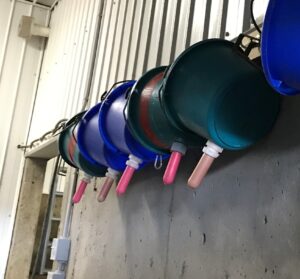
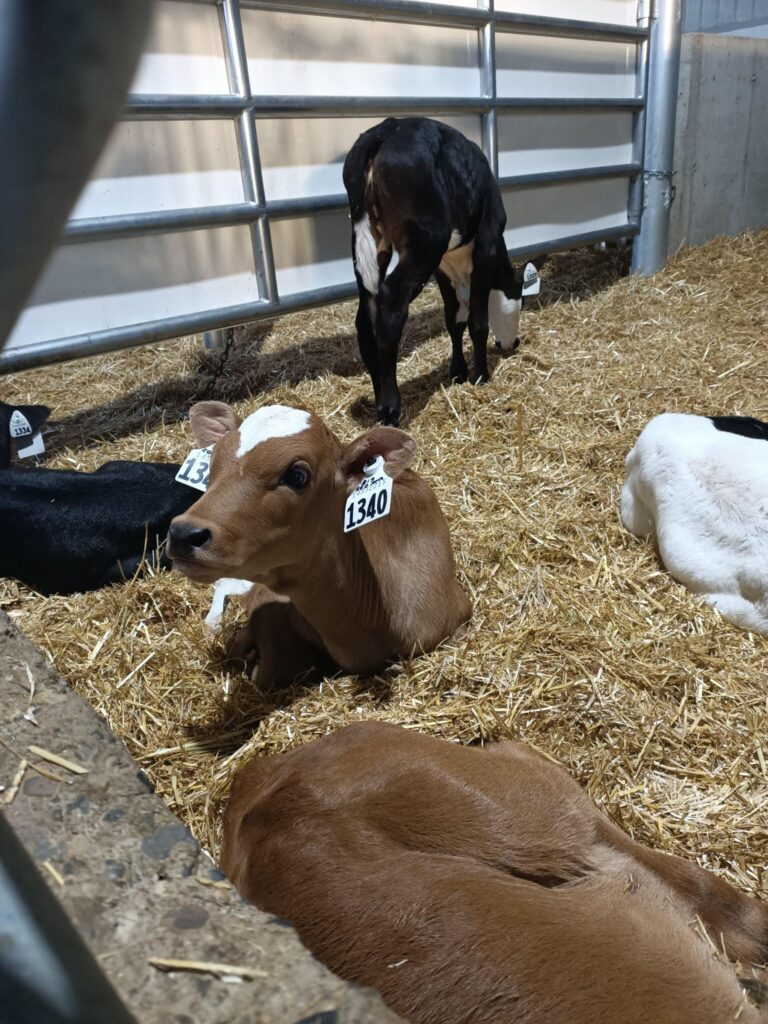
It is routine practice to separate dairy calves from their mothers within 24 hours of birth. It is done this early for a few reasons:
- The stress of weaning is decreased, since the cow and calf have had very little time to bond [1], [2].
- By moving the calves to a controlled environment, there is a lower risk of developing some diseases [3]-[6].
- By grouping the calves together with other calves of the same size and age, they are less likely to be injured or stepped on by a full-grown cow.
- The exact quantity of colostrum and milk that a calf eats can be carefully monitored. If a calf is not eating, the cause can be quickly investigated.
It should be noted that there is a lack of consensus about the benefits of early cow/calf separation. Despite the risks, there are documented health benefits to keeping cows and calves together longer, such as increased immunoglobulin absorption from colostrum, decreased calf mortality, and reduced mastitis in cows [7]-[10]. Each farm weighs the risks and benefits to determine their management strategies.
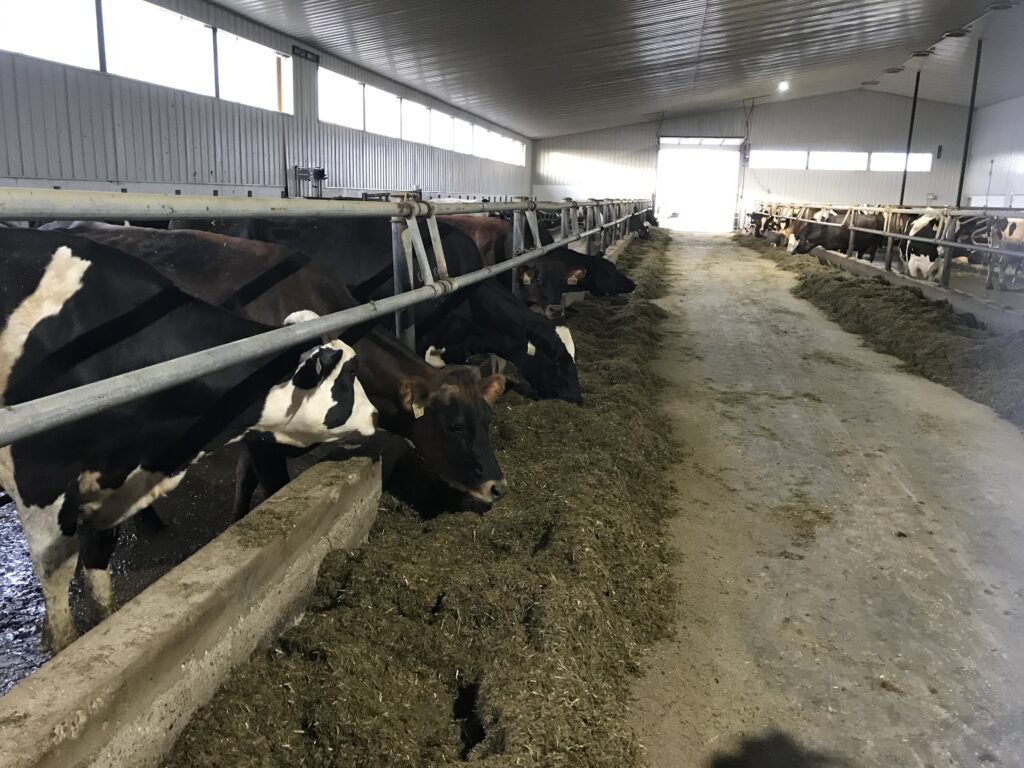
Unlike in the beef cattle industry, where cattle need to have robust immune systems, the dairy cattle industry has strict sanitation and biosecurity standards because of food production implications. This also helps ensure the cows’ health.
Animals are grouped roughly by age/size to reduce bullying of the younger/smaller animals. These groupings typically consist of:
- Heifers: females that have not yet had offspring.
- Lactating cows: cows that are actively producing milk. They are often kept in an indoor barn.
- Dry cows: cows that have stopped producing milk.
The lactating cows are milked at least twice a day. Machine milking is a more common practice than manual milking, as it is more time efficient. Manual milking is typically only used on small farms. Cows that are being treated with antibiotics will still be milked twice daily, however all of their milk will be discarded during the mandatory withdrawal period. All milk is tested for antibiotics prior to being processed and any milk that is contaminated will be discarded.
The breed of the cow along with feed composition contribute to the fat content of the milk. Higher fat milk is used to make milk products such as yogurt and cheese.
One of the main proteins found in milk, casein, has 2 variants – A1 and A2. Opposed to ordinary milk than contains both A1 and A2 proteins, A2 milk contains only the A2 protein. A2 milk is gaining popularity as it is suggested to be easier to digest.
Connection to Beef Cattle
As male dairy calves cannot produce milk, they will be sold and raised as beef cattle. Most veal is sourced from these male dairy calves. Additionally, calves with undesirable genetics, such as low milk production, will be bred with beef breeds and the respective offspring will be utilized within the beef industry. Lastly, older cows whose milk production has declined will be sold for beef.
Mastitis
Mastitis is the most common, and the most costly, disease in the dairy cattle industry [11]. It is the inflammation of the mammary gland, and causes decreased milk production. In most cases, mastitis is caused by a bacterial infection of the udder tissue.
The condition can be prevented by maintaining a clean environment for the cows, including the bedding, barn facilities, and milking equipment. Treatment of the disease often involves the use of antibiotics. The milk from cows being treated with antibiotics cannot be marketed or sold in Canada.
Technologies
- Automated passage scrapers clean the flooring of the barn as frequently as every hour. Along with built in floor drainage, this helps to maintain sanitary conditions in the barn.
- As cows and their calves are separated shortly after birth, automatic milk feeders for calves are used to provide easy access to milk. The feeders can measure the milk intake of each individual calf, and will notify the farmers if any calves are not feeding enough.
- Automatic feed pushers are used to bring the feed closer and more accessible to the cows as they eat throughout the day. This helps to increase feed intake.
- Cows are able to move freely around the barn, but have separate stalls to lie down and rest in. These stalls are separated by bars to provide comfortable spacing and prevent the cows from stepping on each others’ udders.
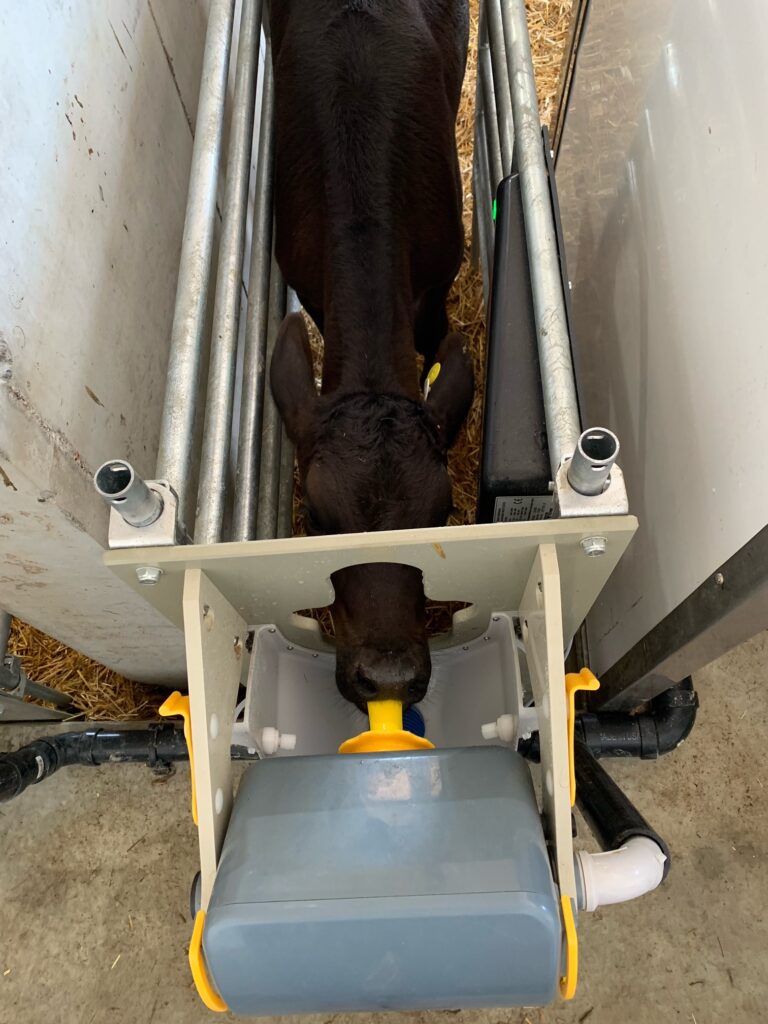
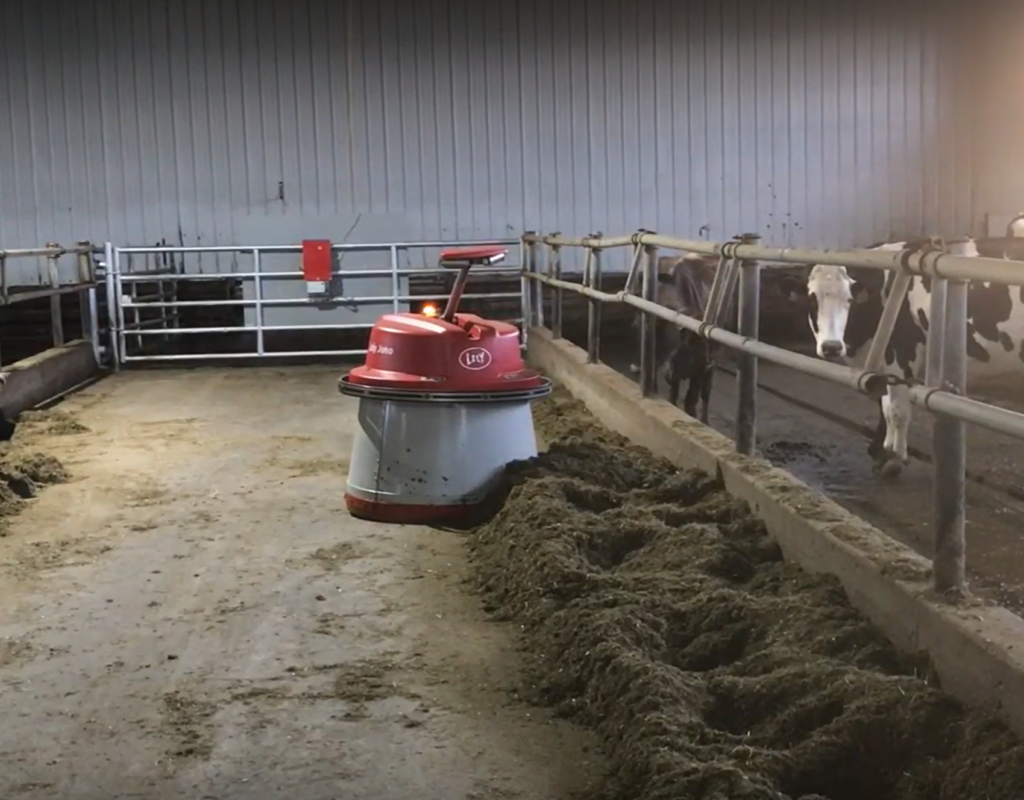
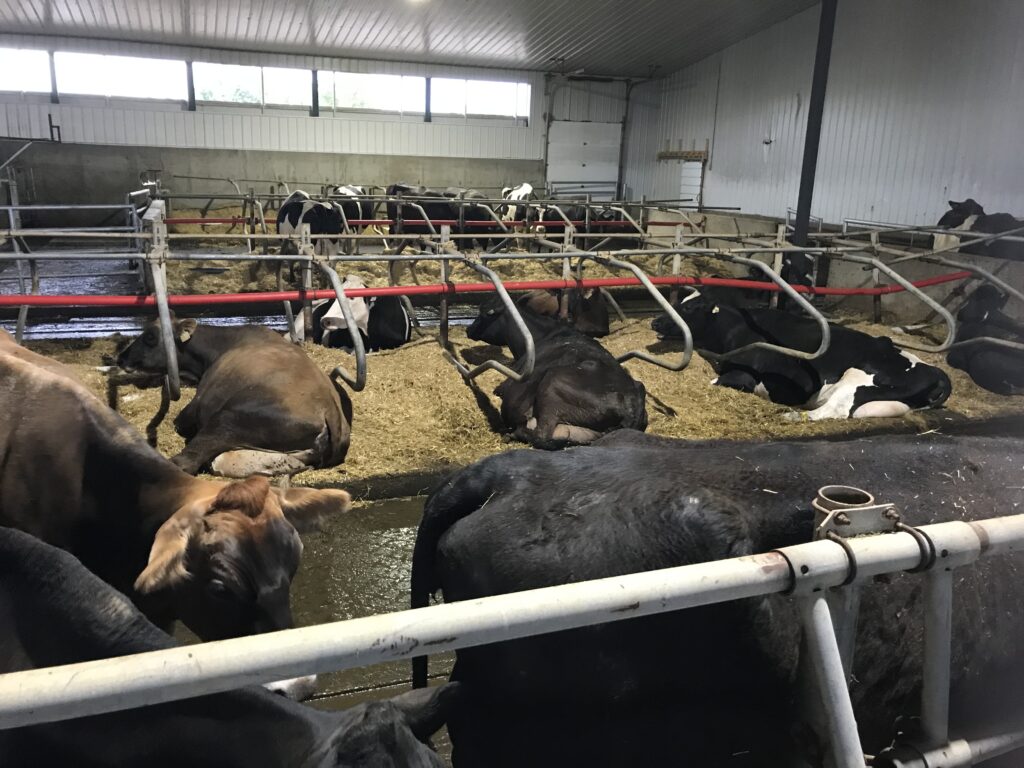
An enormous thank you to Crystal Springs Dairy Company for their insightful facility tours and for granting us permission to share photos and videos from their farm.
Further Reading
References
[1] D. M. Weary and B. Chua, ‘Effects of early separation on the dairy cow and calf: 1. Separation at 6 h, 1 day and 4 days after birth’, Appl. Anim. Behav. Sci., vol. 69, no. 3, pp. 177–188, Oct. 2000, doi: 10.1016/S0168-1591(00)00128-3.
[2] I. Stěhulová, L. Lidfors, and M. Špinka, ‘Response of dairy cows and calves to early separation: Effect of calf age and visual and auditory contact after separation’, Appl. Anim. Behav. Sci., vol. 110, no. 1, pp. 144–165, Mar. 2008, doi: 10.1016/j.applanim.2007.03.028.
[3] G. M. Faubert and Y. Litvinsky, ‘Natural Transmission of Cryptosporidium Parvum Between Dams and Calves on a Dairy Farm’, J. Parasitol., vol. 86, no. 3, pp. 495–500, Jun. 2000, doi: 10.1645/0022-3395(2000)086[0495:NTOCPB]2.0.CO;2.
[4] J. Muskens, A. R. W. Elbers, H. J. Van Weering, and J. P. T. M. Noordhuizen, ‘Herd Management Practices Associated with Paratuberculosis Seroprevalence in Dutch Dairy Herds’, J. Vet. Med. Ser. B, vol. 50, no. 8, pp. 372–377, 2003, doi: 10.1046/j.1439-0450.2003.00697.x.
[5] A. Daugschies and M. Najdrowski, ‘Eimeriosis in Cattle: Current Understanding’, J. Vet. Med. Ser. B, vol. 52, no. 10, pp. 417–427, 2005, doi: 10.1111/j.1439-0450.2005.00894.x.
[6] S. M. McGuirk, ‘Disease Management of Dairy Calves and Heifers’, Vet. Clin. North Am. Food Anim. Pract., vol. 24, no. 1, pp. 139–153, Mar. 2008, doi: 10.1016/j.cvfa.2007.10.003.
[7] G. H. Stott, D. B. Marx, B. E. Menefee, and G. T. Nightengale, ‘Colostral Immunoglobulin Transfer in Calves. IV. Effect of Suckling’, J. Dairy Sci., vol. 62, no. 12, pp. 1908–1913, Dec. 1979, doi: 10.3168/jds.S0022-0302(79)83522-5.
[8] F. J. Alvarez, G. Saucedo, A. Arriaga, and T. R. Preston, ‘Effect on Mink Production and Calf Performance of Milking Cross Bred European/Zebu Cattle in the Absence or Presence of the Calf, and of Rearing Their Calves Artificially’, Trop Anim Prod, vol. 5, no. 1, pp. 25–37, 1980.
[9] J. P. Walsh, ‘Milk Secretion in Machine-Milked and Suckled Cows’, Ir. J. Agric. Res., vol. 13, no. 1, pp. 77–89, 1974.
[10] A. Beaver, R. K. Meagher, M. A. G. von Keyserlingk, and D. M. Weary, ‘Invited review: A systematic review of the effects of early separation on dairy cow and calf health’, J. Dairy Sci., vol. 102, no. 7, pp. 5784–5810, Jul. 2019, doi: 10.3168/jds.2018-15603.
[11] K. Sharun et al., ‘Advances in therapeutic and managemental approaches of bovine mastitis: a comprehensive review’, Vet. Q., vol. 41, no. 1, pp. 107–136, Jan. 2021, doi: 10.1080/01652176.2021.1882713.

